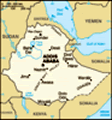Advertisement
Published: April 10th 2008
March 17, 2008
Flight: Lalibela (LLI) to Bahar Dar (BJR), Ethiopian Airlines 127, F50, Economy
Hotel: Hotel Summerland, $45 We woke up at 6 AM this morning. The shower did have hot water, but the water had a very strong iron/rust/sulphur smell, and the water pressure was negligible. I guess that explained the lack of a shower curtain. We had breakfast (included) at the hotel before meeting our guide around 7AM. He had his 'official' guide jacket on. We walked back up into town and to the ticket office. We noticed the two-story huts that were typical for the area. Several new hotels had been built in this style. Today was Sunday, so there were hundreds of worshipers around the churches, many come and sleep outside overnight. It was a mass of people, most in white robes but there were occasional splashes of color. Although it wasn't supposed to open until 8AM the ticket office was already open at 7:30, the ticket price had recently doubled to 200 birr ($22). The churches at Lalibela have been hewn from the rock, some of them are 2 or 3 stories tall. Most date back to the 11th/12th century. The UN has started
putting up scaffolding and roofs to protect the more vulnerable churches from the elements. Some of the churches are damaged from earthquakes or just wear and tear. The king Lalibela had visited Jerusalem, and had a vision that he was supposed to build a new Jerusalem in Ethiopia; when he returned he started a massive church construction program. Thousands of workers were needed, and it was said the angels continued the work at night. Each church was different style, some were Axumite style with alternating levels carved to look like wood beams and false windows, other churches had Greek crosses or swastikas. All around the churches were pilgrims and monks praying and chanting. You have to take your shoes off to enter the churches, there are carpets on the floor to help soften but you are still walking on bare uneven rock. ouch. Most churches were very dim inside, some were painted or had amazing colored religious themes (St. George was very popular). Each church has its own priest and church treasures, usually these are crowns and crosses, which they bring out to show to tourists. Most priests look really bored when they do this, I imagine they do this
many times a day. The priests put on sunglasses when you take flash photos, which does make for cool pictures. :D You leave a tip of $0.50-$1 per church. Each church cross is different, there is a Lalibela style cross which has a cross in the middle surrounded by a horseshoe shaped curve with 12 tines representing the apostles. Most of the crosses are hundreds of years old. A few years ago, one was stolen and sold to a tourist, luckily it was recovered. The UN has also been working on cataloguing Ethiopia's treasures to ensure this doesn't happen again. Most churches also have their own Bibles. Many of these are hundreds of years old as well, printed and illuminated in bright colors on goatskin in Ge'ez, an ancient language. The alphabet is the same as Amharic, but the words are only known to the old priests (does this make them Geezers?)
There are 11 churches in total, in three different groups. We finished the first (Northern) group by 9 AM, then walked down through town to the Bet Giorgis church. This is the most famous of the churches in Lalibela, it is cross-shaped and still in good enough
condition to not require scaffolding. We were in luck too, the church service was still going on and there were several dozen worshippers standing on the other side of the church. Most of the churches are too small to actually hold services, so they are held outside with the priest on a loudspeaker. Most photos I have seen of the St. George church don't have people in it, so it was nice to get photos with locals in the background! The church is quite amazing, the pit surrounding it is maybe 50-60 feet wide, and another 30 feet deep. There is a side tunnel that leads down to the bottom. Several alcoves lined the side of the pit, some of them contained mummified skeletons. This was probably the most scenic of the churches, with moss growing on the side. When we came out of the church the service was over, so we had just gotten there in time. I don't think we had seen another tourist this whole morning! The Southern group of churches were next... these weren't as impressive as they were in worse condition, and we were starting to get tired/thirsty by this time. However saving the best
for last, after going through a dark tunnel some distance we emerged at Bet Emmanuel, another Axumite style church in good condition. We headed back to the hotel for lunch, and to checkout. Our flight to Bahar Dar wasn't until 4 PM so we still had a little time to kill. Our guide suggested visiting another monastery nearby that had more manuscripts. The monastery was on the way to the airport, they could take us there, drop us off then come back and pick us up when they took the other guests to the airport later that afternoon. The guide was really expensive though, $60 for the day when probably that's more than most Ethiopians earn in a month. We had noticed prices had gone up on most things anywhere 10%-200% from the prices in the Lonely Planet and the book was only a year old, and that's due not the decline of the dollar. The USD-Birr rate has been pretty stable, if anything it's one of the few currencies that has been heading in a favorable direction. We went souvenir shopping and bought a few crosses before heading to the new monastery. This one was different from the others,
not carved out of the rock but built into the side of a cliff like a pueblo village. 'Holy' water dripped from the ceiling into a pool. The church treasures here included some beautiful manuscripts and crosses. As we emerged from the monastery, several villagers had set out handicrafts to sell. I bought a beautifully carved gourd for a few $ that had been used to store butter; it looked nice but I ended up ditching it later as it smelled horrible, even after washing it several times. But at least my money went to help the locals directly there. As we were waiting for the bus, some boys invited me to play foosball for $0.10. I won the first goal but then lost the rest of the match after getting grease from the spin pole all over my hands! The hotel shuttle soon picked us up and we were on our way to the airport. There are only a few flights a day and everyone shows up at once, even though our flight was still almost 2 hrs away. The airport is tiny, just a few checkin desks and a cafe upstairs. There is also a souvenir stall here,
the prices were actually pretty comparable to those we had seen in town. Finally our flght arrived for the quick trip to Bahar Dar, the flight is only about 30 minutes. Much quicker than the overland trip which can take two days! We had spent 24 hrs in Lalibela, and I think that was plenty of time to see everything there. There are other churches further afield if you have more time to visit.
After arriving in Bahar Dar had a bit of a scare as only one of our bags came through; turnarounds are quick on ET flights but luckily they found my bag! By the time we had come out of the terminal there was only one taxi left, ours was the last flight of the day and we were the only passengers getting off here. The ride into town was 60 birr, about $6.50. Very different scenery here in Bahar Dar than Lalibela, much flatter here but there are volcanic cinder cones all over. We had reserved a room at the Summerland, a new hotel on the main street. Same price ($45) as the Hotel Jerusalem and nicer. We had a bit of a wait till
they could find a room with two single beds, meanwhile we arranged for a trip out to the monasteries and the Blue Nile falls for the next day. We went down the street to a nearby restaurant for dinner, excellent and delicious fish with St. George beer while we watched people walking down below on the street. All this for $4! We liked the feel of Bahar Dar, the main street was lined with palm trees and there were couples and single women walking down on the street even after it got dark; not something I had usually seen in other parts of Africa. Ethiopia felt like a very safe place. After dinner, we decided to check out a local wandering minstrel bar the book had recommended, the Belageru club was just around the corner from the hotel. It was so much fun! It was a tiny place, only could hold maybe 30 people. The singers come out and play bawdy lyrics, while audience members clap to the tune. Dancers come out and try to get the audience to come and dance; we being the only foreigners there of course the girls came up to get us to dance! I
don't need much an excuse so got up and danced for awhile, what a blast! I was quite exhausted by this point, jetlag was finally starting to kick in so we went back to crash.
Advertisement
Tot: 0.103s; Tpl: 0.018s; cc: 12; qc: 28; dbt: 0.0469s; 1; m:domysql w:travelblog (10.17.0.13); sld: 1;
; mem: 1.1mb












